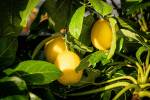Edible flowers elegant way to jazz up entrees
When your guests ask what's for dinner, tell them marigolds, pansies and nasturtiums. We are all familiar with herbs in our foods and now we're seeing edible flowers -- which were a big thing in the Victorian days -- coming back into fashion. It's proving to be more than a passing fad.
Many innovative chefs and home cooks garnish their entrees with flower blossoms for a touch of elegance. When using edible flowers, the key is keeping the dish simple so you'll enjoy the delicate flower tastes.
Deborah Cospella is a certified chef who uses edible flowers in her entrees. She will show you flowers to please your palate and teach you how to use them at 2:30 p.m. Saturday at the Springs Preserve, 333 S. Valley View Blvd. Call 822-7786 to reserve your seat and for planning purposes so guests can sample the entrees.
The rise of edible flowers in our meals is concurring with the advent of the organic health food movement. We want to eat and grow our own fresh produce in lieu of ingesting inferior fast foods and commercially produced ingredients made hundreds of miles away.
Flowers are tasty, fresh and couldn't be more local than if they came straight from your garden. Cookbooks are popping up in bookstores that show how to use flowers for eating, rather than just enjoying their beauty.
Growing edible flowers is the same as growing flowers for ornamental purposes. These pesky plants love a well-drained open friable soil tucked under a blanket of mulch to keep them warm through the winter. The warmth will keep them producing flowers through the colder months. Mulch also conserves moisture, reduces weeds and reduces soil splashing onto your desired flowers.
Let's go right to harvesting these unusual edibles.
Flavor will vary because of growing conditions and varieties, so expect different tastes than what you might be accustomed to. Do your own taste test before harvesting large amounts of flowers; you may have to wait until they finish maturing. Avoid flowers not fully opened and discard those past their prime. It's best to harvest early in the morning to get the greatest taste. If you harvest more than you need, place flowers in plastic bags with damp paper towels and store in a refrigerator to maintain their quality.
Pollen may ruin a flower's true flavor, so remove the pistils and stamens. It also will reduce chances of allergic reactions. Remove sepals of all flowers except violas, Johnny-jump-ups and pansies. The white base of flower petals such as chrysanthemums, dianthus, marigolds and roses have a bitter taste, so remove the white base.
You also can preserve fresh flowers for later use if you keep them in airtight containers in a cool, dark place. Avoid dark-colored petals, because they have a tendency to turn even darker.
Flowers can deteriorate quickly. They wilt or become mushy if cooked too long or drowned in heavy sauces. Many recipes call for adding flowers just before serving your meal.
Note what plants you can grow to enjoy their flowers: anise, artichoke, borage, calendula, chervil, chive, coriander, day lily, garlic, garden mum, hyssop, lavender, nasturtium, pea, pineapple guava, okra, oregano, pansy, rosemary, rose of Sharon, sage, snap dragon, squash, sunflower thyme, tulip, viola and yucca.
Three very important things you need to remember: 1. Not every flower is edible. In fact, some flowers can make you sick. 2. Never use pesticides on plants you intend on eating. 3. Use flowers sparingly, because digestive complications can occur if you consume too much.
Here are some ideas for your edible flower landscapes:
■ Put pots of herbs and flowers on your patio to move around and show off. Grow them in hanging baskets.
■ Grow nasturtium, violas or calendula and use flowers in salads.
■ Grow red-jewel cabbage with the traditional green varieties.
■ Plant colorful pepper varieties alongside flowers.
■ Tuck lettuce, or other short-lived greens, into a flowerbed.
■ Try "rainbow" chard with your calendulas.
■ Grow chives around the mailbox with tulips.
The following plant combinations work well:
■ Curly parsley and yellow pansies (violas).
■ Red leaf lettuce with yellow and orange calendulas.
■ Dwarf curly kale with dusty miller and dianthus.
Linn Mills writes a garden column each Sunday. You can reach him at linn.mills@springspreserve.org or call him at 822-7754.























